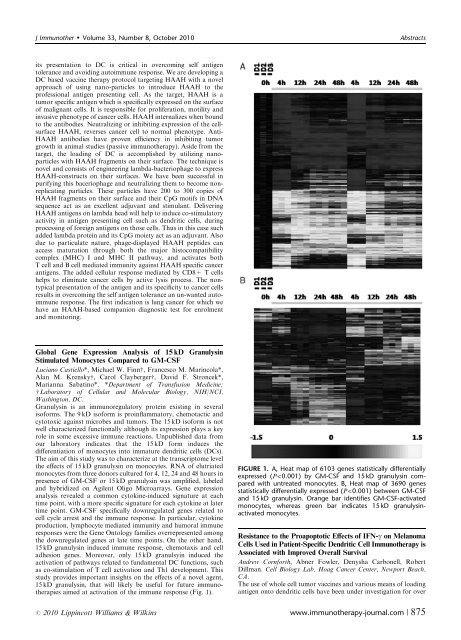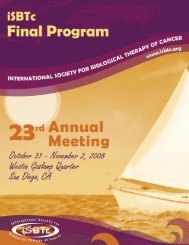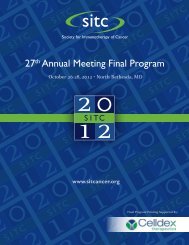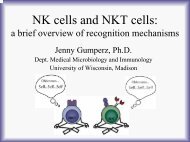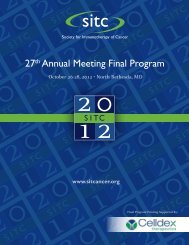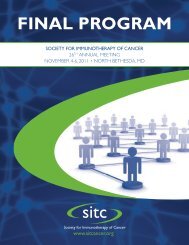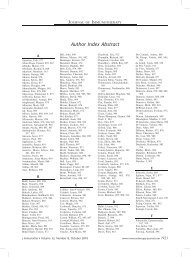Abstracts for the 25th Annual Scientific Meeting of the International ...
Abstracts for the 25th Annual Scientific Meeting of the International ...
Abstracts for the 25th Annual Scientific Meeting of the International ...
Create successful ePaper yourself
Turn your PDF publications into a flip-book with our unique Google optimized e-Paper software.
J Immuno<strong>the</strong>r Volume 33, Number 8, October 2010<br />
<strong>Abstracts</strong><br />
its presentation to DC is critical in overcoming self antigen<br />
tolerance and avoiding autoimmune response. We are developing a<br />
DC based vaccine <strong>the</strong>rapy protocol targeting HAAH with a novel<br />
approach <strong>of</strong> using nano-particles to introduce HAAH to <strong>the</strong><br />
pr<strong>of</strong>essional antigen presenting cell. As <strong>the</strong> target, HAAH is a<br />
tumor specific antigen which is specifically expressed on <strong>the</strong> surface<br />
<strong>of</strong> malignant cells. It is responsible <strong>for</strong> proliferation, motility and<br />
invasive phenotype <strong>of</strong> cancer cells. HAAH internalizes when bound<br />
to <strong>the</strong> antibodies. Neutralizing or inhibiting expression <strong>of</strong> <strong>the</strong> cellsurface<br />
HAAH, reverses cancer cell to normal phenotype. Anti-<br />
HAAH antibodies have proven efficiency in inhibiting tumor<br />
growth in animal studies (passive immuno<strong>the</strong>rapy). Aside from <strong>the</strong><br />
target, <strong>the</strong> loading <strong>of</strong> DC is accomplished by utilizing nanoparticles<br />
with HAAH fragments on <strong>the</strong>ir surface. The technique is<br />
novel and consists <strong>of</strong> engineering lambda-bacteriophage to express<br />
HAAH-constructs on <strong>the</strong>ir surfaces. We have been successful in<br />
purifying this baceriophage and neutralizing <strong>the</strong>m to become nonreplicating<br />
particles. These particles have 200 to 300 copies <strong>of</strong><br />
HAAH fragments on <strong>the</strong>ir surface and <strong>the</strong>ir CpG motifs in DNA<br />
sequence act as an excellent adjuvant and stimulant. Delivering<br />
HAAH antigens on lambda head will help to induce co-stimulatory<br />
activity in antigen presenting cell such as dendritic cells, during<br />
processing <strong>of</strong> <strong>for</strong>eign antigens on those cells. Thus in this case such<br />
added lambda protein and its CpG moiety act as an adjuvant. Also<br />
due to particulate nature, phage-displayed HAAH peptides can<br />
access maturation through both <strong>the</strong> major histocompatibility<br />
complex (MHC) I and MHC II pathway, and activates both<br />
T cell and B cell mediated immunity against HAAH specific cancer<br />
antigens. The added cellular response mediated by CD8+ T cells<br />
helps to eliminate cancer cells by active lysis process. The nontypical<br />
presentation <strong>of</strong> <strong>the</strong> antigen and its specificity to cancer cells<br />
results in overcoming <strong>the</strong> self antigen tolerance an un-wanted autoimmune<br />
response. The first indication is lung cancer <strong>for</strong> which we<br />
have an HAAH-based companion diagnostic test <strong>for</strong> enrolment<br />
and monitoring.<br />
Global Gene Expression Analysis <strong>of</strong> 15 kD Granulysin<br />
Stimulated Monocytes Compared to GM-CSF<br />
Luciano Castiello*, Michael W. Finnw, Francesco M. Marincola*,<br />
Alan M. Krenskyw, Carol Claybergerw, David F. Stroncek*,<br />
Marianna Sabatino*. *Department <strong>of</strong> Transfusion Medicine;<br />
w Laboratory <strong>of</strong> Cellular and Molecular Biology, NIH/NCI,<br />
Washington, DC.<br />
Granulysin is an immunoregulatory protein existing in several<br />
iso<strong>for</strong>ms. The 9 kD iso<strong>for</strong>m is proinflammatory, chemotactic and<br />
cytotoxic against microbes and tumors. The 15 kD iso<strong>for</strong>m is not<br />
well characterized functionally although its expression plays a key<br />
role in some excessive immune reactions. Unpublished data from<br />
our laboratory indicates that <strong>the</strong> 15 kD <strong>for</strong>m induces <strong>the</strong><br />
differentiation <strong>of</strong> monocytes into immature dendritic cells (DCs).<br />
The aim <strong>of</strong> this study was to characterize at <strong>the</strong> transcriptome level<br />
<strong>the</strong> effects <strong>of</strong> 15 kD granulysin on monocytes. RNA <strong>of</strong> elutriated<br />
monocytes from three donors cultured <strong>for</strong> 4, 12, 24 and 48 hours in<br />
presence <strong>of</strong> GM-CSF or 15 kD granulysin was amplified, labeled<br />
and hybridized on Agilent Oligo Microarrays. Gene expression<br />
analysis revealed a common cytokine-induced signature at each<br />
time point, with a more specific signature <strong>for</strong> each cytokine at later<br />
time point. GM-CSF specifically downregulated genes related to<br />
cell cycle arrest and <strong>the</strong> immune response. In particular, cytokine<br />
production, lymphocyte mediated immunity and humoral immune<br />
responses were <strong>the</strong> Gene Ontology families overrepresented among<br />
<strong>the</strong> downregulated genes at late time points. On <strong>the</strong> o<strong>the</strong>r hand,<br />
15 kD granulysin induced immune response, chemotaxis and cell<br />
adhesion genes. Moreover, only 15 kD granulsyin induced <strong>the</strong><br />
activation <strong>of</strong> pathways related to fundamental DC functions, such<br />
as co-stimulation <strong>of</strong> T cell activation and Th1 development. This<br />
study provides important insights on <strong>the</strong> effects <strong>of</strong> a novel agent,<br />
15 kD granulysin, that will likely be useful <strong>for</strong> future immuno<strong>the</strong>rapies<br />
aimed at activation <strong>of</strong> <strong>the</strong> immune response (Fig. 1).<br />
FIGURE 1. A, Heat map <strong>of</strong> 6103 genes statistically differentially<br />
expressed (P


